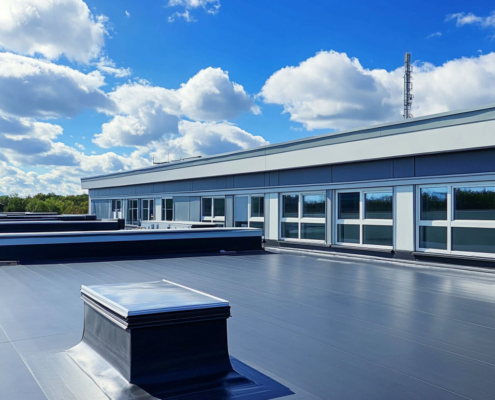Why PVC Roofing is a Smart Choice for Long-Lasting Roofs
PVC (Polyvinyl Chloride) roofing is a highly popular roofing material, offering durability, flexibility, and energy efficiency for both residential and commercial applications. Known for its ability to withstand harsh weather conditions and provide superior insulation, PVC roofing is a wise investment for property owners looking for a long-term, low-maintenance solution. This article dives into the benefits of PVC roofing systems, how they compare with other roofing types, and the installation and maintenance tips to ensure your PVC roof lasts for decades.
Benefits of PVC Roofing Systems: Why Choose PVC?
PVC roofing provides several significant advantages, making it a go-to option for many property owners:
- Durability and Weather Resistance
- PVC roofs are engineered to withstand extreme weather, including hail, heavy rain, snow, and high winds.
- The material resists damage from UV rays, corrosion, and chalking, making it ideal for both hot and cold climates.
- With a lifespan of up to 50 years, PVC roofs offer long-term value for property owners seeking a dependable solution.
- Energy Efficiency
- PVC roofing reflects sunlight, reducing heat absorption and keeping the building cooler in the summer. This reflective property can lower cooling costs by up to 30%.
- The insulation capabilities of PVC roofs help retain heat in winter, making them energy-efficient year-round and ideal for locations with varying climates.
- Low Maintenance Requirements
- PVC is highly resistant to mold, mildew, and algae, reducing the need for regular cleaning and maintenance.
- The material’s smooth surface makes it easy to clean, often requiring only mild soap and water to maintain its appearance.
- Eco-Friendly and Recyclable
- PVC roofing is made from recyclable materials, and many manufacturers offer recycling programs for PVC at the end of its life cycle.
- With its long lifespan, PVC roofing reduces the frequency of replacements, lowering the overall environmental impact.
- Aesthetic Flexibility
- PVC roofs come in a variety of colors and styles, allowing property owners to choose options that enhance their building’s curb appeal.
- Many PVC roofing systems can be customized to match a specific aesthetic, making them a versatile option for residential and commercial properties alike.
Types of PVC Roofing Systems and How They Work
PVC roofing systems are available in different styles and installation methods, making them versatile for various roofing needs:
- Single-Ply PVC Membranes
- Single-ply PVC roofing membranes are lightweight yet strong, offering flexibility and durability for flat or low-slope roofs.
- They are installed as a single layer, typically adhered to a substrate with adhesive or fasteners, providing waterproof protection with minimal seams.
- Mechanically Attached PVC Roofs
- In this installation method, the PVC membrane is attached to the roof deck using corrosion-resistant fasteners.
- This method provides added durability in high-wind areas, ensuring the roof remains securely in place during extreme weather.
- Fully Adhered PVC Roofs
- Fully adhered PVC roofs are bonded to the substrate using a specialized adhesive, creating a strong, secure bond that enhances weather resistance.
- This type of PVC roof is ideal for buildings with complex roof shapes, as it provides flexibility without compromising stability.
- PVC Green Roofing Systems
- PVC membranes can be used as a base layer for green roofing systems, where vegetation is planted on the roof.
- The waterproof and durable nature of PVC protects the building structure while supporting sustainable green roofing practices.
Installation Process: How to Install a PVC Roof
PVC roofing installation is straightforward but requires precision to ensure the roof’s integrity:
- Preparation and Substrate Installation
- A substrate of plywood or particle board is typically installed as a base for PVC roofing, providing a stable surface.
- The substrate is cleaned and leveled to ensure the PVC membrane can be applied smoothly.
- Applying the PVC Membrane
- The PVC membrane is rolled out over the substrate, with sections aligned and secured using adhesives or fasteners.
- To secure seams, installers use a heat-welding technique, which creates a watertight seal and enhances the roof’s resistance to leaks.
- Adding Reinforcements
- For areas around vents, chimneys, or other protrusions, flashing is applied to reinforce these vulnerable spots.
- Sealant or caulking may be added to edges and corners for extra protection against water infiltration.
- Final Inspection and Sealant Application
- Once the membrane is installed, the roof is inspected for proper adhesion and sealed for waterproofing.
- Any minor adjustments are made to ensure the roof’s durability and weather resistance.
Comparing PVC Roofing to Other Flat Roofing Systems
PVC roofing offers unique benefits but can be compared with other popular flat roofing materials:
- PVC vs. TPO Roofing
- Durability: PVC roofing has superior chemical and fire resistance, making it ideal for buildings with rooftop grease traps or exposure to harsh chemicals.
- UV and Puncture Resistance: TPO typically offers better protection against UV damage and punctures, which can make it more suitable for regions with high sun exposure.
- Cost: PVC is generally more expensive than TPO but offers longer-lasting benefits in terms of chemical and fire resistance.
- PVC vs. EPDM Roofing
- Weather Resistance: PVC outperforms EPDM in withstanding extreme temperatures and resisting UV damage.
- Seam Strength: PVC’s heat-welded seams are stronger and more watertight than EPDM’s taped or glued seams.
- Flexibility: EPDM may be more flexible for complex shapes, but PVC offers superior durability in a variety of climates.
Common Questions About PVC Roofing Systems
Is PVC Roofing Better than EPDM?
PVC roofing is more resistant to chemicals, fire, and UV radiation compared to EPDM. While EPDM is flexible and cost-effective, PVC’s heat-welded seams provide better waterproofing, making it ideal for commercial buildings.
How Long Does a PVC Roof Last?
With proper maintenance, a PVC roof can last between 25 to 50 years, depending on the installation quality and local climate conditions.
Can I Install a PVC Roof Myself?
While small repairs can be DIY, PVC roofing installation requires professional expertise for proper heat-welding and seam sealing.
Maintenance Tips for PVC Roofing Systems
- Regular Inspections
- Inspect your PVC roof twice a year, especially after extreme weather, to check for signs of wear or damage.
- Cleaning and Debris Removal
- Clean the roof surface with mild soap and water to remove dirt, debris, and pollutants that could affect reflectivity.
- Address Minor Repairs Promptly
- For small cracks or punctures, apply PVC-compatible sealant. Addressing minor issues promptly prevents larger, costly repairs down the line.








